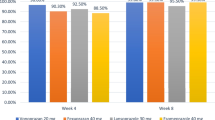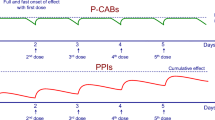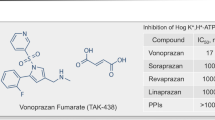Abstract
Purpose
Hypergastrinaemia induced by proton pump inhibitor (PPI) therapy may cause ECL-cell and parietal-cell hyperplasia and rebound hyperacidity and dyspepsia after PPI withdrawal. The aim of the study was to assess the effect of different dosage-regimens of netazepide, a gastrin/CCK2 receptor antagonist, on PPI-induced hypergastrinaemia and elevated chromogranin A (CgA).
Methods
Six groups of eight healthy subjects participated in a randomised, double-blind study of esomeprazole 40 mg daily for 28 days, in combination with netazepide 1, 5 or 25 mg or placebo, daily, during the last 14 days of esomeprazole or during 14 days after treatment withdrawal. Fasting serum gastrin and plasma CgA were measured during treatment and after withdrawal, as biomarkers of acid suppression and ECL-cell activity, respectively. Dyspepsia was monitored throughout the study.
Results
Esomeprazole increased gastrin and CgA. Netazepide increased gastrin, but not CgA, and inhibited dose dependently the CgA response to esomeprazole. Gastrin and CgA returned to baseline within 2–3 days of esomeprazole withdrawal; netazepide did not shorten that time. There was no rebound dyspepsia after esomeprazole withdrawal.
Conclusions
Esomeprazole and netazepide each increase gastrin, consistent with a secondary effect of gastric acid suppression, but by different mechanisms. Esomeprazole-induced hypergastrinaemia stimulates ECL cells and thereby increases CgA. Netazepide-induced hypergastrinaemia does not increase CgA, because netazepide blocks gastrin/CCK2 receptors on ECL cells. Co-administration of netazepide 5 mg abolishes the effect of esomeprazole-induced hypergastrinaemia on ECL cells. The quick return to baseline of gastrin and CgA and absence of dyspepsia after esomeprazole withdrawal do not support the concept of rebound hyperacidity.






Similar content being viewed by others
References
Dockray GJ, Varro A, Dimaline R, Wang T (2001) The gastrins: their production and biological activities. Ann Rev Physiol 63:119–139
Dimaline R, Varro A (2007) Attack and defence in the gastric epithelium—a delicate balance. Exp Physiol 92:591–601
Dimaline R, Varro A (2014) Novel roles of gastrin. J Physiol 592:2951–2958
Schmitz F, Göke MN, Otte JM, Schrader H, Reimann B, Kruse ML, Siegel EG, Peters J, Herzig KH, Fölsch UR, Schmidt WE (2001) Cellular expression of CCK-A and CCK-B gastrin receptors in human gastric mucosa. Reg Pept 102:101–110
Bakke I, Qvigstad G, Sandvik AK, Waldum HL (2001) The CCK2 receptor is located on the ECL cell, but not on the parietal cell. Scand J Gastroenterol 36:1128–1133
Schubert ML, Peura DA (2008) Control of gastric acid secretion in health and disease. Gastroenterology 134:1842–1860
Carlsson E, Larsson H, Mattsson B, Ryberg B, Sundell G (1986) Pharmacology and toxicology of omeprazole—with special reference to the effects on the gastric mucosa. Scand J Gastroenterol 118:31–38
Larsson H, Carlsson E, Håkanson R, Mattsson H, Nilsson G, Seensalu R, Wallmark B, Sundler F (1988) Time-course of development and reversal of gastric endocrine hyperplasia after inhibition of acid secretion. Studies with omeprazole and ranitidine in intact and antrectomised rats. Scand J Gastroenterol 95:1477–1486
Nishida A, Kobayashi-Uchida A, Akuzawa S, Takinami Y, Shishido T, Kamato T, Ito H, Yamano M, Yuki H, Nagakura Y et al (1995) Gastrin receptor antagonist YM022 prevents hypersecretion after long-term acid suppression. Am J Phys 269:G699–G705
Waldum HL, Arnestad JS, Brenna E, Eide I, Syversen U, Sandvik AK (1996) Marked increase in gastric acid secretory capacity after omeprazole treatment. Gut 39:649–653
Gillen D, Wirz AA, Ardill JE, McColl KE (1999) Rebound acid hyper secretion after omeprazole and its relationship to on-treatment acid suppression and H. pylori status. Gastroenterology 116:239–247
Hunfeld NG, Geus WP, Kuipers EJ (2007) Systematic review: rebound acid hypersecretion after therapy with proton pump inhibitors. Aliment Pharmacol Ther 25:39–46
Reimer C, Søndergaard B, Hilsted L, Bytzer P (2009) Proton-pump inhibitor therapy induces acid-related symptoms in healthy volunteers after withdrawal of therapy. Gastroenterology 137:80–87
Niklasson A, Lindström L, Simrén M, Lindberg G, Björnsson E (2010) Dyspeptic symptom development after discontinuation of a proton pump inhibitor: a double-blind placebo-controlled trial. Am J Gastroenterol 105:1531–1537
National Institute for Clinical Excellence (2014) Dyspepsia and gastro-oesophageal reflux disease: investigation and management of dyspepsia, symptoms suggestive of gastro-oesophageal reflux disease, or both. NICE guideline
Vakil N (2012) Prescribing proton pump inhibitors: is it time to pause and rethink? Drugs 72:437–445
McColl KE, Gillen D (2009) Evidence that proton-pump inhibitor therapy induces the symptoms it is used to treat. Gastroenterology 137:20–22
Takemoto Y, Yuki H, Nishida A, Ito H, Kobayashi-Uchida A, Takinami Y, Akuzawa S, Ohta M, Satoh M, Semple G, Miyata K (1998) Effects of YF476, a potent and selective gastrin/CCK-B receptor antagonist, on gastric acid secretion in beagle dogs with gastric fistula. Arzneim Forsch 48:403–407
Boyce M, Warrington S, Black J (2013) Netazepide, a gastrin/CCK2 receptor antagonist, causes dose-dependent, persistent inhibition of the responses to pentagastrin in healthy subjects. Br J Clin Pharmacol 76:689–698
Boyce M, Dowen S, Turnbull G, van den Berg F, Zhao CM, Chen D, Black J (2015) Effect of netazepide, a gastrin/CCK2 receptor antagonist, on gastric acid secretion and rabeprazole-induced hypergastrinaemia: a double-blind trial in healthy subjects. Br J Clin Pharmacol 79:744–755
Bonapace ES, Fisher RS, Parkman HP (2000) Does fasting serum gastrin predict gastric acid suppression in patients on proton-pump inhibitors? Dig Dis Sci 45:34–39
Ligumsky M, Lysy J, Siguencia G, Friedlander Y (2001) Effect of long-term, continuous versus alternate-day omeprazole therapy on serum gastrin in patients treated for reflux oesophagitis. J Clin Gastroenterol 33:32–35
Sanduleanu S, Stridsberg M, Jonkers D, Hameeteman W, Biemond I, Lundqvist G, Lamers C, Stockbrügger RW (1999) Serum gastrin and chromogranin a during medium- and long-term acid suppressive therapy: a case-control study. Aliment Pharmacol Ther 13:145–153
Sanduleanu S, De Bruïne A, Stridsberg M, Jonkers D, Biemond I, Hameeteman W, Lundqvist G, Stockbrügger RW (2001) Serum chromogranin a as a screening test for gastric ECL cell hyperplasia during acid-suppressive therapy. Eur J Clin Investig 31:802–811
Pregun I, Herszényi L, Juhász M, Miheller P, Hritz I, Patócs A, Rácz K, Tulassay Z (2011) Effect of proton-pump inhibitor therapy on serum chromogranin a level. Digestion 84:22–28
Talley NJ, Verlinden M, Jones M (2001) Quality of life in functional dyspepsia: responsiveness of the Nepean dyspepsia index and development of a new 10-item short form. Aliment Pharmacol Ther 15:207–216
Redrup MJ, Leaf FC, Miyashita A, Watanabe T, Higuchi S, Chasseaud LF, Cheng KN (2002) Validation of a liquid chromatographic-tandem mass spectrometric method for the measurement of (R)-1-[2,3-dihydro-2-oxo-1-pivaloylmethyl-5-(2-pyridyl)-1H-1,4-benzodiazepin-3-yl]-3-(3methylaminophenyl) urea (YF476) in human plasma. J Chromatography 772:317–325
Lundell L, Vieth M, Gibson F, Nagy P, Kahrilas PJ (2015) Systematic review: effects of PPI on serum gastrin levels and gastric histology. Aliment Pharmacol Ther 42:649–663
Metz DC, Pilmer BL, Han C, Perez MC (2011) Withdrawing proton pump inhibitor therapy after healing esophagitis does not worsen symptoms or cause persistent hypergastrinaemia: analysis of dexlansoprazole MR clinical trial data. Am J Gastroenterol 106:1953–1960
Acknowledgements
We thank the volunteers who took part in the study and our many colleagues who helped carry out the study. In particular, we thank Bhavini Ladwa for data management, Torkjel Matzow and Lucy Ball for the study report and Lauren Garden for Figs. 2, 3, 4, 5 and 6.
Authors’ contributions
MB designed and, together with FvdB and SW, carried out the study. TM did the statistical analyses. MB wrote the manuscript. SW and KD contributed to the final version. All authors approved the final version.
Author information
Authors and Affiliations
Corresponding author
Ethics declarations
Conflict of interest
MB owns HMR and Trio. SW, FvdB, KD and TM are HMR employees.
Funding
The study was funded by Trio Medicines, London, England (Trio), a subsidiary of Hammersmith Medicines Research (HMR).
Rights and permissions
About this article
Cite this article
Boyce, M., van den Berg, F., Mitchell, T. et al. Randomised trial of the effect of a gastrin/CCK2 receptor antagonist on esomeprazole-induced hypergastrinaemia: evidence against rebound hyperacidity. Eur J Clin Pharmacol 73, 129–139 (2017). https://doi.org/10.1007/s00228-016-2150-x
Received:
Accepted:
Published:
Issue Date:
DOI: https://doi.org/10.1007/s00228-016-2150-x




